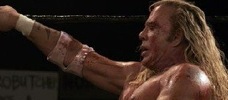Reviews
Darren Aronofsky
USA, 2008
Credits
Review by Leo Goldsmith
Posted on 23 October 2008
Source Fox Searchlight 35mm print
There are many overtly self-reflexive gestures in Darren Aronofsky’s The Wrestler, but the most obvious is its casting of Mickey Rourke as its title character, a scarred and sequined warhorse in the world of pro-am wrestling. As Randy “The Ram” Robinson, Rourke launches himself off turnbuckles, rouses the crowd into a frenzy, and finishes his opponents with a signature move called “the Ram Jam.” All of this is done not so much to make a big comeback as to exploit the last traces of the fame his body has brought him—before that body gives out entirely.
A gift from the film’s director, the character of Randy is in every way a vessel for Rourke’s own career and nebulous star persona—his early bad-boy sex-symbol stardom (Diner, Nine 1/2 Weeks, Angel Heart, Wild Orchid) and the fallow period of bit-parts and easy paychecks that followed (Harley Davidson and the Marlboro Man, Another Nine 1/2 Weeks). During this time, Rourke tried to defy his age by becoming a professional boxer, a career-move that occasioned a series of facial injuries for which he received reconstructive surgery. Now brutalized and prettified, both the actor and his wrestler-character form a knotty totem of self-destruction-as-performance, his body juiced and bed-tan orange, his hair bleached blonde, and his face precariously reassembled after a career of face-smashing pugilism.
The Wrestler is a curious amalgam of pop-culture tributes, Aronofsky’s double love-letter to Mickey and to the stars of what used to be called the WWF (as in “Macho Man” Randy Savage, not endangered wildlife). Opening with an uncannily apt, intentionally cheesy credit sequence, complete with various Randy-the-Ram-obilia, fan-mag clippings, and lime-green typeface, the film is scored with a beautifully tinny soundtrack of 80’s hair-metal (Ratt, Cinderella, Quiet Riot; Randy later describes Kurt Cobain as “a pussy”). But all this is twenty years in the past, a time when the Ram’s epic battles with The Ayatollah were legendary. Now all that remains is Randy’s attempt to cling to his former days of glory, driving around (and often sleeping) in his Dodge Ram van, an action figure of himself perched on the dashboard, and self-medicating with J.D., Vitamin Water, and a pharmacy-load of pills and syringes. On weekdays, Randy ties back his sandy-white mane and puts in his hearing-aid to load boxes and work the deli counter at the local Acme supermarket, somewhere in Central Jersey. But on Saturdays, Randy is the Ram again, headlining events at American Legion halls in his tight, sparkly leggings.
Throughout The Wrestler, Aronofsky’s camera cuddles close to the actor, taking in every performative sleight, every nuance of humiliation and physical agony in which Rourke and the Ram (real name: Robin Ramzinsky) engage. Trading in the weird congealed aspic of The Fountain for a hyperrealism more in line with the styles of Hou Hsiao-hsien, the Dardennes, and latter-day Gus Van Sant, Aronofsky documents the many rituals of wrestling: the pre-show choreography short-hand; the half-fake, half-real slamming and crunching; and the very real gouges with staples, barbed wire, shards of broken glass, and razor-blade fragments. The film is careful to show the consequences of these performances on Rourke/the Ram’s body, intercutting one particularly grueling “Xtreme” wrestling match with the post-show triage of stitches and staple-removal, followed by vomiting and a heart attack.
But for all this bludgeoning and degradation, this gut-wrenching exploration of Rourke/ Randy as a self-described “old, broken-down piece of meat,” The Wrestler is really a rather touching and intimate film. Rourke’s performance is nothing short of heartbreaking in its honesty, but he’s still funny and charming, whether palling with the local kids who live near his mobile home, lying prone in a hospital bed, wheezing in the locker-room, or serving up potato salad at the deli counter. The script (written by former Onion Editor-in-Chief Robert Siegel) also features two requisite subplots that round out the film’s emotional center: a barely developed (and mercifully brief) storyline with Evan Rachel Wood as Randy’s estranged daughter, and a far more involving narrative featuring Marisa Tomei as an aging stripper named Cassidy (real name: Pam). Cassidy’s profession of lap-dances and pole-dancing is no less ritualized and physically demanding (or degrading) as Randy’s world of pro-wrestling—and no less worthy of a film of its own.
If these parts of the film’s narrative arc occasionally seem predictable and rudimentary, they also cleverly reflect the satisfying predictability of an epic wrestling bout, with its cheers and boos, anger-fuelling low-blows, and crowd-pleasing come-from-behind victories. We know more or less where the whole thing’s going: There will be “one last fight”; the father-daughter reconciliation will seem to work and then turn sour; the romance between Pam and Randy will have to take a backseat to the career demands of Cassidy and the Ram; there will be unsubtle comparisons between the Ram and Christ (or more specifically, Mel Gibson’s The Passion of the Christ. “Tough dude,” comments the Ram). But as in a wrestling match, these perfunctory notes, however predictable, still hit home and successfully work our emotions. It’s a story we’ve seen before, but we’re not there for the story so much as the way it’s performed. And it’s Rourke’s performance and the intimacy with which it’s rendered that make The Wrestler what it is, what it’s about. As Randy tells Pam late in the film, “The only place I get hurt is out there,” in the harsh unforgiving real world of crappy jobs, ephemeral fame, and impending mortality. Within the circumscribed glory of the ring, the performance is all, and Randy the Ram is invincible.
We don’t do comments anymore, but you may contact us here or find us on Twitter or Facebook.



